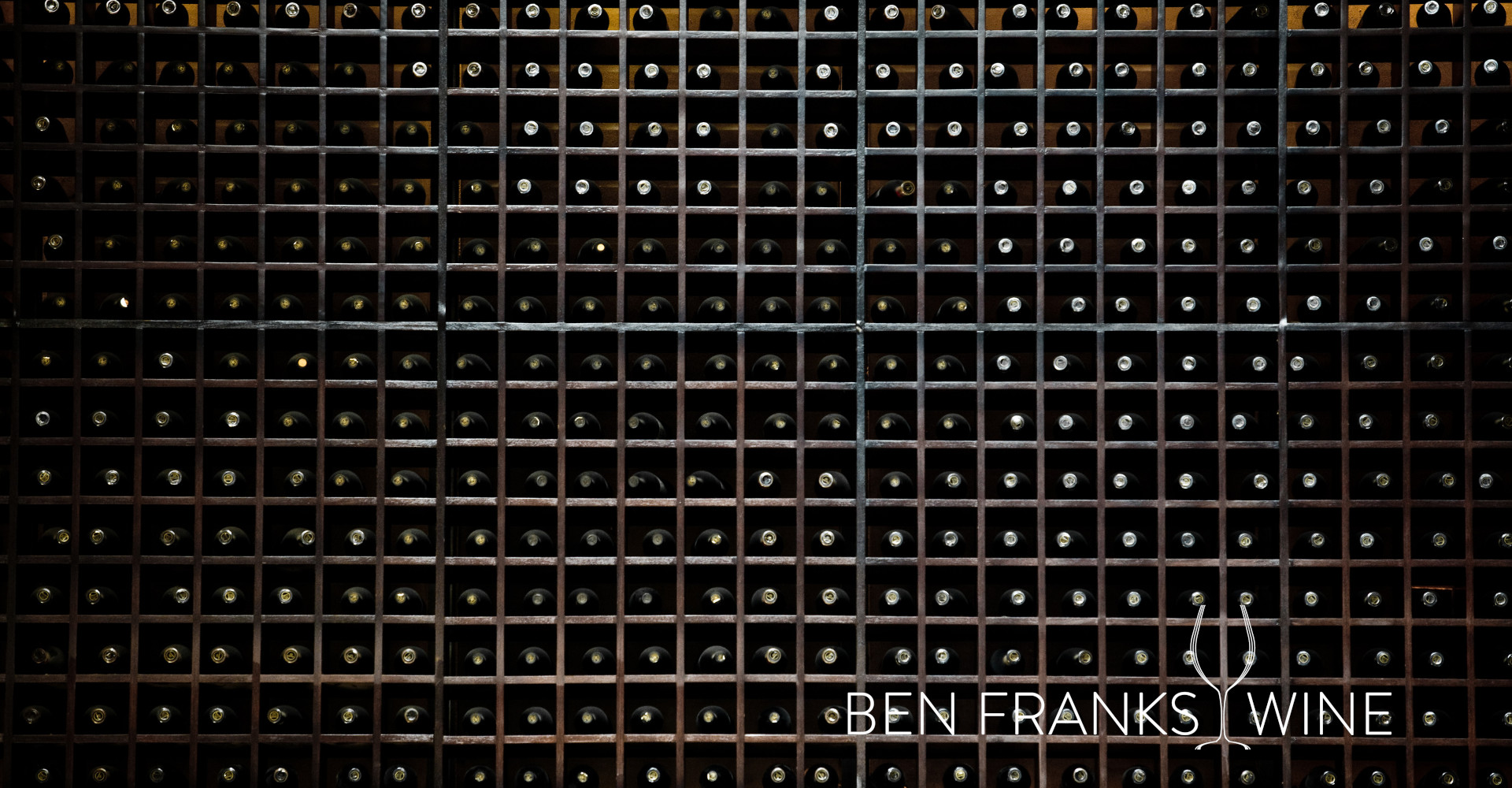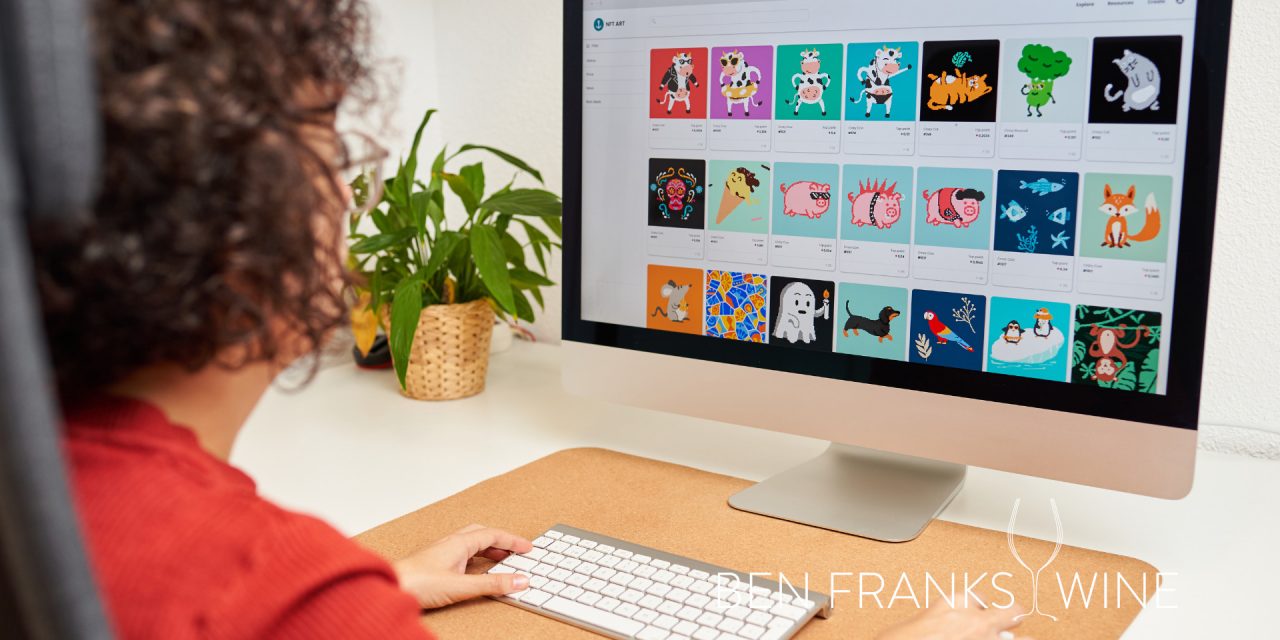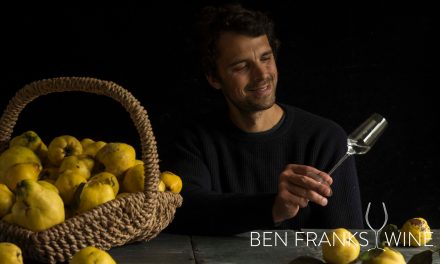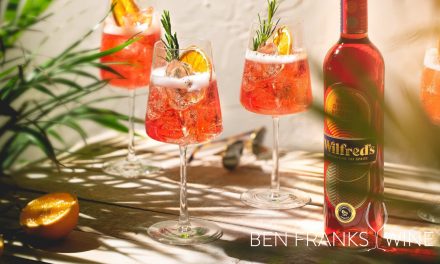Non fungible tokens might sound like a confusing or distant future, but could this new movement offer wine enthusiasts and wine businesses a golden opportunity?
Certified wine geek and Web 3.0 professional Graeme Brandham‘s debut insight for Ben Franks Wine explains what an NFT is and looks at the opportunity for NFTs and Web 3.0 to bring greater parity between consumer and business value in wine.
If you have been following the wine industry over the last year, you will have noticed a new phenomenon. Winemakers and wine businesses have not lost any time in bringing together their wines and NFTs (Non-fungible tokens) in new and creative ways. From tokenised en primeur offerings by independent wineries, wine clubs that use NFTs as the membership and governance pass, and of course fine wine investment.
But this activity has left a lot of people scratching their heads. What even is an NFT and how does it benefit me as a winemaker or consumer? Let’s take a quick step back from what has been done with wine and NFTs so far and explore the potential pros and cons for us wine lovers in this new technology.
What is an NFT?
To get familiar with the basic terminology, an NFT is a cryptographically unique piece of the digital layer, recorded on the blockchain, that you can own. Think of it as a small piece of digital real estate. NFTs can be programmed to do many things, and we are just beginning to scratch the surface of that potential.
What is blockchain?
In the most basic sense, a blockchain is simply a recorded ledger of data custodied by many people or devices all at once.

The blockchain. A decentralised, peer-to-peer network.
This allows it to remain decentralised and trustless. Trustless in that you can interact peer to peer without any middle management. It can get very technical quickly when it comes to blockchain, so let’s instead consider the normal winemaking process as a neat metaphor. When you buy a wine, the underlying structure of the wine is something you can consume only. You have no ability to affect its production, structure, and price in normal circumstances. You cannot decide the grapes that go into it, when they are picked, or how they are handled. It is out of your hands. There is a creator (the winemaker) and there is a consumer (you) with a hard line drawn between the two.
The internet as we know it, sometimes called ‘web 2.0’, functions in much the same way as this winemaking process. It is highly centralised and you are simply an interacting consumer. Blockchain, however, lays the foundation for a new ‘web 3.0’.
This Web 3.0 is nicely described by Brian Brooks, CEO of Bitfury, to the US Senate earlier this year, which I’ve paraphrased below:
“…So originally the internet was a read-only format, for consuming information, then there were additional layers placed upon it that made it more interactive. But, counter-intuitively, much more centralized on web 1 and web 2. So what are the characteristics that define web 1 and web 2?
“The characteristic of web 1 was an ability to look at a curated walled garden, at a set of content that was not interactive, that was presented to you much like a magazine, just on a screen.
“The innovation of web 2 was that suddenly you could not only read the content but write content (you could interact with it). This is when the blogosphere really kicked off in the late 90s and early 2000s.
“The reason for the centralisation of the internet, of course, was that all of this activity was being monetised by a few big companies, Facebook, Google, etc.
“What makes web 3 different is the ability to own the actual network. That’s what crypto-assets themselves actually represent. An ownership stake in an underlying network. This is your reward for providing the ledger maintenance services that help keep the network up and running. Tasks that were previously heavily centralised, and therefore controlled.”
In the winemaking example. Web 3.0 would almost represent the equivalent of a vineyard that is owned and managed by an entire community of thousands of people. A community who you could make decisions with in a democratic voting system. And, at the end, you are rewarded with a case of wine that you earned by participating in the running of the winery.
As you can see, the huge imbalance of autonomy over your digital life from the highly centralised web 2.0 is now being addressed, and that is with things like cryptocurrency and NFTs.
So an NFT is a token on the blockchain, but what is fungibility?
To put this into its simplest terms, something that is fungible has the ability to be readily interchanged for another object of like-kind such as bank notes or indeed a cryptocurrency like Bitcoin. Goods that are alike but not necessarily interchangeable such as cars, houses and certain types of fine wine are non-fungible. This is also the case for an NFT.
When we indulge in wine, whether as wine hobbyists or wine professionals, one of the first things we begin to appreciate about our wines is their incredible ability to be almost entirely unique from one bottle to the next (aka, non-fungible). Wine is a living thing and will develop in unique ways.
Of course, a lot of winemakers strive for consistency in their wines. This is why non-vintage champagne will use a proportion of the previous year’s harvests when blending the new year’s wine. The use of many years of grapes in one bottle creates the illusion of a smooth, pristine, glittering glass of perfection that is consistent from one year to the next. A champagne experience that is just how the champagne houses intended. Consistently delicious.
However, the illusion is not entirely infallible. With every bottle of wine, whether from the same vintage, the same winemaker, the same grapes, or even the same barrel, they will all experience mitigating circumstances that will subtly change the flavour. Add in the way it’s stored, the lighting conditions it is displayed in, the relative temperature when it is served, and so on, every wine will – by its nature – be different from bottle to bottle. It is entirely fair to say that every single bottle of wine is going to have its own degree of uniqueness.
There are very few things in this world that are human-made, which can be said to hold that particular ability to be entirely unique in every example. Perhaps handmade arts and crafts which are made from scratch rather than printed or manufactured are great examples of something that is bespoke. However, this ability to be completely unique has been translated into the realm of the digital using NFTs.
Non-Fungible-Tokens.
So what do NFTs and Blockchain contribute?
Consider for a moment the world we live in. There is a layer to this world that cannot be perceived and yet is ever-present. You can’t touch it or taste it. You can only see it by inference. This is the digital layer. Almost like an invisible blanket spread out over the world we inhabit. It occupies such a huge part of our day-to-day interactions that we can scarcely live without it.
Sometimes you will interact with this digital layer, perhaps when you use a debit card or a mobile phone to pay for goods. You will see the coloured lights on the contact reader that show you something has happened and that you are now somewhat lighter in the purse than before. This interaction and others like this are so common as to be almost invisible, just the normal running of things. However, consider what else aside from payments has been absorbed by this digital layer.
- When was the last time you applied for a job by dropping off a physical c.v. at a reception desk?
- When was the last time you communicated a message to a friend using your voice?
- When was the last time you bought a book at a high street shop?
- When was the last time you watched a film in the cinema rather than streamed it?
- When was the last time you submitted your taxes in paper format?
- When was the last time you had to worry about there being bananas on the shelves because they haven’t been ordered by the store?
The digital layer is everywhere.
The caveat to all of this is that, until recently, you could only interact with the digital layer. You do not own it, you cannot change it, and it’s unlikely you can do much about the data this digital layer has accumulated about you. Data that is used to generate profits for a small enclave of super-powerful companies.
This brings in the reasons for NFTs and cryptocurrency existing. The remedy for an overly centralised digital layer. A complete people-owned, decentralised network allowing us all to interact in a trustless and tangible way that has value.
So how can NFTs and blockchain benefit the wine industry specifically?
There have been many bad examples of how to use NFTs and cryptocurrency, no doubt most of us will have heard of some of them in the news. Speculative runs on NFTs representing an image have been rife, and for some, costly. The hype around NFT profile pictures and digital art has exemplified this)
Much like the internet in its formative stages, not every exploratory use case of an NFTs potential will survive but the essential tool, the basic piece of digital real estate, is likely here to stay for a very long time. Not only does it give you the opportunity to now contribute and interact with the digital layer in a way that confers autonomy and rights, it also allows you to do something else. It allows you to hold, own and experience something completely unique. Much like our friendly neighborhood wine of paragraphs past, the NFT is, as the name suggests, non-fungible.

Fine wines are already being tokenised on the blockchain and being turned into financial assets.
There has already been an exploration of how fine wines could be invested in, using NFTs as proxies for the value of the wine and treating the digital entity similar to a privately owned micro contract between a wine investment company and the wine investor.
Particular benefits the blockchain and NFTs usage confers include:
- Peer-to-peer trading without the need for a broker;
- No burdensome import/export costs;
- No need for personal storage or the knowledge required to store wine safely;
- The tokenisation of the value of wine allows it to be used as a financial instrument. In the past, it is unlikely you could have taken a log of your wine cellar to a bank and received a loan against its value – however, this is now possible by tokenising the wine on a trustless and un-editable blockchain;
- Ownership of the value of the wine without the need to actually hold it.
But it can confer even more. An NFT could function as a key that unlocks your data when you interact with websites. Instead of a company holding all your data and bothering you with constant questions about how they can use it, you can instead hold the key and permissions to that data yourself in an NFT, and potentially begin to see the value of your data come back to you in small ways.
Not only this, but it can store multiple pieces of information. Imagine being able to interact with every store, and every website in a way that when you ‘log-in’ from your private NFT key, the shop already knows your preferences and can guide you to new recommendations automatically.
This could open up a whole new world for winemakers too. Imagine being able to reward a long-term customer with a wine that exactly matches their tastes because they own one of your winery’s NFTs.
This leads me to the next use case for NFTs in the wine industry.
Your NFT could be a digital membership pass for your favourite wineries and any associated events; a membership pass that is stored in one location and owned by you. No more constantly fluctuating subscription fees and innumerable plastic cards and emails cluttering up your wallets and inboxes whether you like them or not. And when you no longer require the membership and its benefits, it can be sold or burnt on the open market for a return on its value. In this way, your participation has value, as much as the product you are participating with. Your value as a customer now has value you can make use of.

NFTs could also represent access and accountability in a wine community.
It can also be a ticket to these wine clubs. Say you have a winery that is doing regular online tastings, there would be no need to sign up for a course every time it renews. Simply log in, and as an owner of the NFT key, you will be granted access via a smart contract that has already negotiated any costs and constraints as pre-agreed by yourself and the winemakers running the event.
Importantly they can even function as evidence of your participation. Imagine a wine community, run by the winery but with a democratic structure that allows its customers and loyal fans to participate. When that winery needs to vote on a particular set of new initiatives, your NFT can confer to you voting rights, access, and authentic traceable actions that cannot be easily manipulated, misrepresented, or deleted.
In fact, voting cards may well become one of the most widely accepted and acknowledged uses for an NFT in general. As I’m sure we have all seen, there are countries where voter fraud, whether existent or not, is causing problems. An NFT voting card linked only to you as a non-fungible human, verified in a trustless and community-owned network, is a very hard thing to manipulate or commit fraud with.
So where does this lead the wine industry in the future?
The strides being made each and every day with the idea of how your unique, cryptographically secured piece of digital real estate can start to empower you as consumers and businesses is only just beginning. The lines between creator and consumer are beginning to blur, and the relationships between companies and their customers will become much more of a two-way street as people begin to take ownership of their value as a customer and contribute to this digital layer in a meaningful way.
How this will affect the wine industry at large is anyone’s guess, but as somewhat of an idealist myself, I can certainly see use cases where small winemakers may be able to circumnavigate the burdensome industrial hierarchies of yesteryear and get their wines in front of much larger, and more engaged audiences than ever before. They can do this while giving back to that community as their relationships grow. I can see the potential for communities to grow around wine regions and wine houses. I can see a world where wine increasingly has value as a financial instrument. I can see a world where the ability to create bespoke and nuanced services will provide winemakers big and small access to cater to their audiences in a way that they have never been able to do before. And, equally, I see a world where customers may begin to have a much more direct and tangible effect on how the industry is managed and deployed.
Most of all, I see a future where there is parity between your value as a customer and your value as a business. Where this is facilitated by a network that cannot be shut down, cheated, broken, or abused.
Perhaps that is very utopian of me, but I am an eternal optimist.
But in the meantime, I would simply like to encourage you all to embrace that beauty in difference. It is our non-fungibility that makes us all beautiful and, likewise, we see this in our wines and our NFTs as well.






